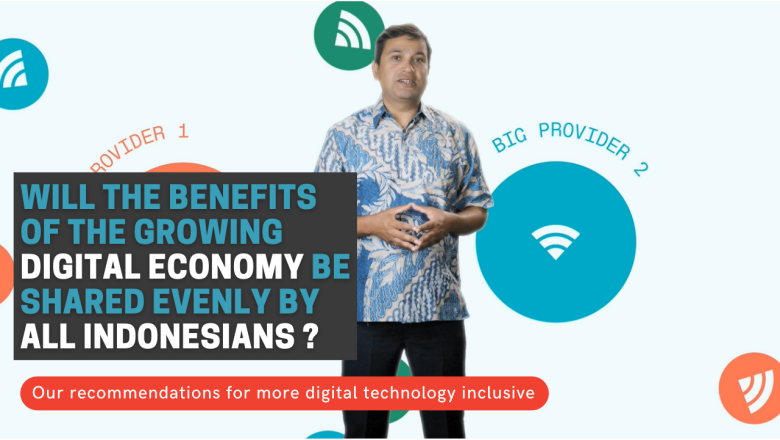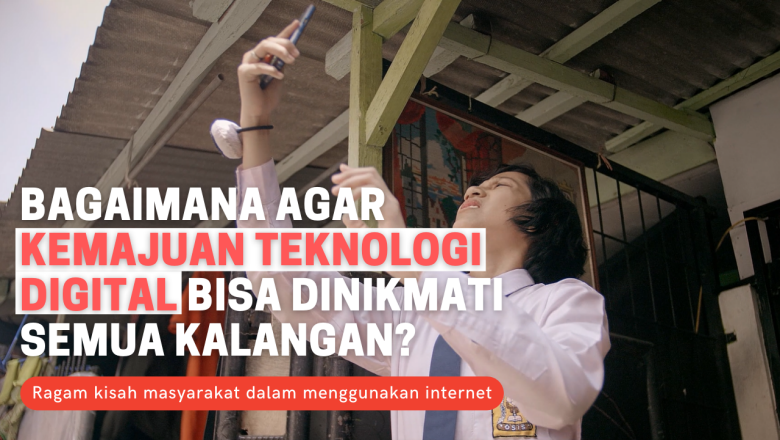Full report (.pdf) | Executive summary (.pdf) | Presentation (.pdf)
MULTIMEDIA

While Indonesia has one of the fastest growing digital economies in South East Asia, action is needed to ensure that all Indonesians, especially the most vulnerable, can access various digital technologies and services and realize the benefits.
Big strides in boosting connectivity, but many left behind
- Fast growth in Internet using population has powered Indonesia to be one of the fastest growing digital economies in South East Asia. Adults with Internet access increased more than three-fold from 13 in 2011 to 51 percent in 2019.
- Indonesians in the top 10 percent of the income distribution are 5 times more likely to be connected to the internet than those in the lowest 10 percent.
- . While private investment in mobile broadband infrastructure has expanded access and brought down the cost of mobile data, cost and affordability is cited as a binding constraint on fixed broadband adoption by 44 percent of Indonesian households.
Consumers benefiting from the growing digital economy
- Indonesians who are connected to the internet use it quite intensively, with communication, social media and leisure applications dominating usage.
- Digital ride hailing is commonly used. It not only provides mobility services to connect the otherwise fragmented labor markets in Indonesia’s large and sprawling metropolitan areas, but also offers other conveniences such as logistics and food delivery, which has especially picked up during the pandemic. One-quarter of all Indonesians and around 36.5 percent of urban dwellers reported having used ride-hailing services before the pandemic.
- Buying and selling online is growing, and while still only prevalent among a small share of the population, it is already enhancing consumer welfare by providing cheaper options, greater product variety and convenience. In 2019, the proportion of Internet-using households that reported buying and selling online was 12.8 and 5.1 percent, respectively.
Newer opportunities for workers, but concentrated in certain sectors, geography and among certain types of workers
- E-commerce is providing an income diversification pathway, particularly for women temporarily dislocated from labor markets and youth. However, e-commerce penetration and intensity are both constrained by limited trust in online transactions and payments, logistics and internet connectivity.
- . However, these opportunities are available primarily to urban men and digital gig workers put in 10 hours a week on average more than every other type of worker in Indonesia.
- Overall, higher skilled workers have benefited more from opportunities in the new economy than the lower skilled ones. A part of the reason why digital dividends haven’t accrued to a broader base of workers is the fact that digital adoption by firms, especially the small and medium ones, remains low and of limited intensity. This is beginning to change during the pandemic and could be supported by complementary policy.
Government leadership to use digital technologies to upgrade the provision of key services at scale crucial to ensuring that no-one is left behind
- Indonesia’s nascent EdTech and HealthTech scene has received a major boost and though these apps have clearly filled a void during the pandemic, their overall reach is limited to the more affluent clientele in urban centers, mostly within Java. For digital technologies to make a dent on the root causes of long-term inequalities, they need to be adopted and applied at scale by the government.
- . Unlocking the potential of this asset could enable millions of Indonesians to connect to and benefit from the digital economy by helping them to securely establish their identities online.
- The government has taken some concrete policy measures in recent years to advance its digital transformation agenda, but experience to date suggests that these efforts have been held back by fragmentation of data and information systems and challenges of coordination across the various agencies and tiers within the government. A platform-based, whole-of-government approach to digital transformation, which has emerged as best practice in many economies globally, is necessary to overcome these challenges. But it is also important to ensure that the agenda is driven by an agency sufficiently empowered to resolve coordination challenges and provide the necessary leadership
MULTIMEDIA

VIDEO
Thus, :
- Expand connectivity and universalize access to good quality internet by, not just addressing the hard infrastructure part, especially along the last mile, but also softer interventions related to competition and sector regulation which have a major bearing on quality and affordability of the Internet, especially for the less affluent.
- Ensure that the digital economy works for all by investing in and facilitating key enablers of the digital economy while at the same time unlocking citizen capabilities to seize the opportunities that are generated. Interventions to make progress on financial inclusion, facilitate trust to promote greater take-up of digital payment services, improve logistics and scale up investment in digital skills as well as a broader set of skills to thrive in the digital economy are some critical elements of that strategy.
- Position the government to lead from the front in harnessing the medium to provide better services and upgrade the quality of citizen-state interactions. This could be achieved by, among others, initiating a whole-of-economy national digital ID framework, implementing a whole-of-government approach to digital transformation driven by an agency sufficiently empowered to resolve crucial inter-agency coordination challenges, and, boosting trust in online transactions by passing the draft Law on Personal Data Protection
- Finally, ensure that all of these efforts to universalize the digital medium and stimulate digital innovations are embedded in a broader ‘bricks-and-mortar’ reform agenda that includes greater openness and competitiveness, stronger regulations, more comprehensive social protection and investments in skills for the future.